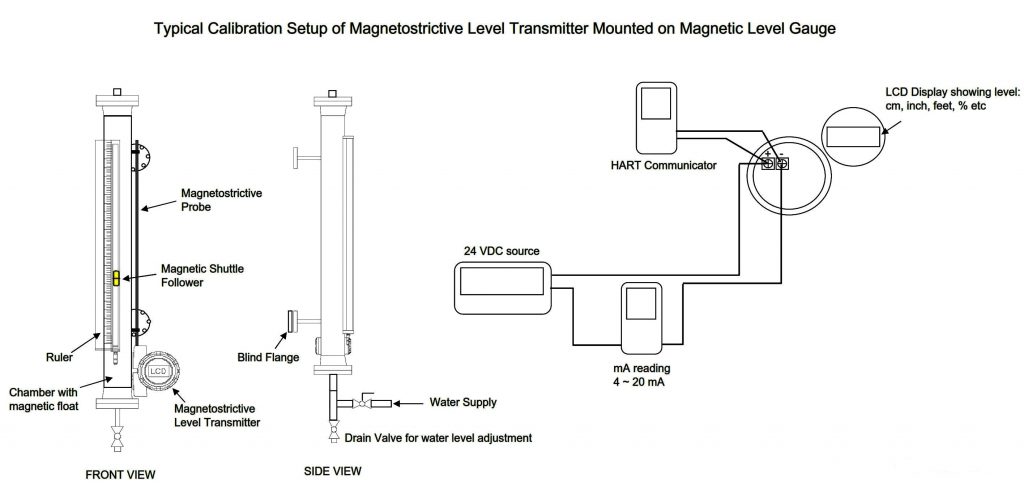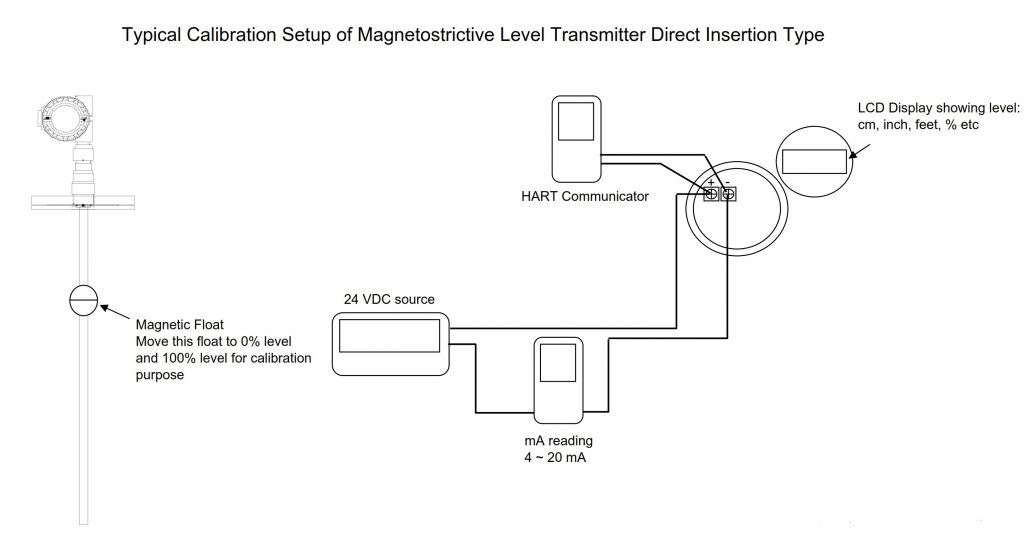Before we calibrate the magnetostrictive level transmitter, we must aware that the float has been produced at factory as per process fluid Specific Gravity (SG), while we will use water as the calibration fluid.
When the magnetostrictive is operated by using actual process fluid, let say it will show the fluid level on 50% float immersion. If we use other fluid (typically water for calibration purpose) the float immersion might be less than 50% or more than 50%, depends on the float designation.
Thus by using water as calibration fluid, there will be some ‘offset’.
The offset problem as explained above can be solved if the magnetostrictive level transmitter is mounted on the magnetic level gauge that has an analogue level indicator.
By using the analogue level indicator, we just need to fill the water until the shuttle or flag indicator in the magnetic level gauge reach the 0% or 100% level without further inspection whether the float and liquid level reach the same level.
This is possible because the magnetostrictive level transmitter is detecting the position of the magnet it self rather than the float immersion on the fluid. If the magnetostrictive doesn’t have any local analogue indicator (magnetic shuttle or flag), we need to disassembly the level transmitter and manually move the float to 0% and 100% level position.
Therefore there are two types of calibration methods, one is using local gauge (magnetostrictive is mounted on magnetic level gauge) and the other one is manually moving the float (direct insertion type).
The water will be used as calibration fluid due to difficulty to use the actual process fluid as calibration fluid.
Magnetostrictive Level Transmitter Mounted on Magnetic Level Gauge

- Set up the magnetostrictive level transmitter, HART communicator, power supply, and the multimeter as below (see below calibration setup file). Attach it to column or temporary support.
- Check the configuration of the lower range value (0% level, 4 mA) and high range value (100% level, 20 mA). Make sure that the inputted data is as per datasheet. For example, the lower range value is 10 inch and the high range value is 35 inch (both of it are measured from the bottom of level transmitter probe)
- Fill the level transmitter chamber with water up to the 0% level (as indicated by magnetic shuttle or magnetic flag). Read the level measurement in the transmitter LCD (or in the HART communicator). Set this condition as 0% level through HART communicator.
- Read the mA output of the transmitter by using a multimeter. Adjust (if any) through the HART communicator so that the output of the transmitter (on multimeter) is 4 mA.
- Fill the level transmitter chamber with water up to the 100% level (as indicated by magnetic shuttle or magnetic flag). Read the level measurement in the transmitter LCD (or in the HART communicator). Set this condition as 100% level through HART communicator.
- Read the mA output of the transmitter by using a multimeter. Adjust (if any) through the HART communicator so that the output of the transmitter (on multimeter) is 20 mA.
Magnetostrictive Level Transmitter Direct Mount Type
- Set up the magnetostrictive level transmitter, HART communicator, power supply, and the multimeter as below (see below calibration setup file). Attach it to column or temporary support.
- Check the configuration of the lower range value (0% level, 4 mA) and high range value (100% level, 20 mA). Make sure that the inputted data is as per datasheet. For example, the lower range value is 10 inch and the high range value is 35 inch (both of it are measured from the bottom of level transmitter probe)
- Manually move the float to the 0% level. Read the level measurement in the transmitter LCD (or in the HART communicator). Set this condition as 0% level through HART communicator.
- Read the mA output of the transmitter by using a multimeter. Adjust (if any) through the HART communicator so that the output of the transmitter (on multimeter) is 4 mA.
- Manually move the float to the 100% level. Read the level measurement in the transmitter LCD (or in the HART communicator). Set this condition as 100% level through HART communicator.
- Read the mA output of the transmitter by using a multimeter. Adjust (if any) through the HART communicator so that the output of the transmitter (on multimeter) is 20 mA.
Alternate Calibration Procedure for Direct Mount Type (on chamber only without local indicator)

- Get float projection calculation from the Vendor. Get this float projection for two values, one for operating specific gravity and one for water as calibration fluid. This float projection calculation will tell to us how deep the float will be immersed in the operating fluid and in the water.
- Calculate the equivalence of water level (for lower range value and high range value) to the operating fluid level by using that float projection data. If the float immersion level by using water as calibration fluid is less than the immersion level by using the operating fluid, then subtract the 0% lower range value and 100% high range value by the difference between that two float projection. If the float immersion level by using water as calibration fluid is more than the immersion level by using the operating fluid, then add the 0% lower range value and 100% high range value by the difference between that two float projection. Example, float projection of the operating fluid is 5”, by using water is 4.5”. The lower range value set in the transmitter is 6” from the bottom of probe. Then water level that we must apply to the level transmitter chamber shall equal to 6 inch – (5 inch – 4.5 inch) = 5.5 inch. When the water level reaches this 5.5 inch, the transmitter should show 0% level.
- Set up the magnetostrictive level transmitter, HART communicator, power supply, and the multimeter as below (see below calibration setup file). Attach it to column or temporary support.
- Check the configuration of the lower range value (0% level, 4 mA) and high range value (100% level, 20 mA). Make sure that the inputted data is as per datasheet. For example, the lower range value is 10 inch and the high range value is 35 inch (both of it are measured from the bottom of level transmitter probe)
- Fill the level transmitter chamber with water up to the equivalence 0% level (as calculated above). Read the level measurement in the transmitter LCD (or in the HART communicator). Set this condition as 0% level through HART communicator.
- Read the mA output of the transmitter by using a multimeter. Adjust (if any) through the HART communicator so that the output of the transmitter (on multimeter) is 4 mA.
- Fill the level transmitter chamber with water up to the equivalence 100% level (as calculated above). Read the level measurement in the transmitter LCD (or in the HART communicator). Set this condition as 100% level through HART communicator.
- Read the mA output of the transmitter by using a multimeter. Adjust (if any) through the HART communicator so that the output of the transmitter (on multimeter) is 20 mA.
Typical tools required:
- 24 VDC power supply
- Multimeter digital
- Water Supply Connection
- HART communicator
- Screwdriver set
- Wrench set
Note:
point number 1, 2, and 4 of the typical tools above can be replaced by a single multitester available in the market.
This typical maintenance procedure is just an illustration of how to regularly service a magnetostrictive level transmitter for academic purpose only. This typical procedure shall not be used as day to day operation guidance. The vendor specific maintenance manual shall be used in detail.

